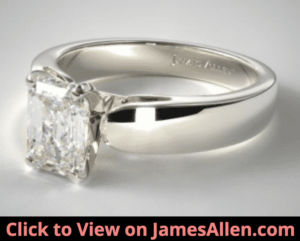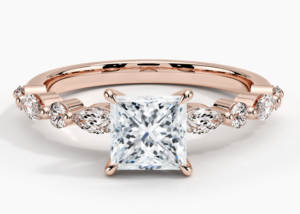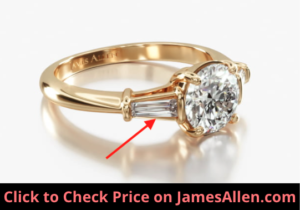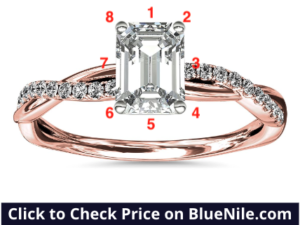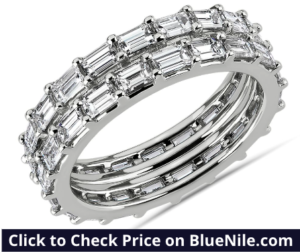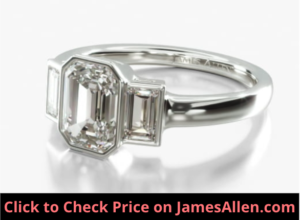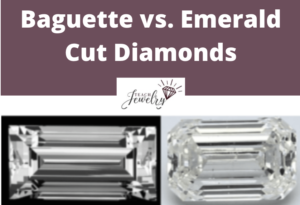
Baguette and emerald cut diamonds look similar at first glance, but each offers a distinct style and performance in jewelry.
The main differences between baguette and emerald cut diamonds are their overall shape and number of facets. Baguette cuts have 14 facets and four sharp corners, creating a rectangular outline. Emerald cuts have 58 facets and cropped corners for a total of eight sides. Both are step-cut diamonds.
Let’s compare baguette versus emerald cut diamonds across their most important characteristics such as facets, price, popularity, durability, and more.
What is a Baguette Cut Diamond?
Baguette cuts are step-cut diamonds known for their elongated, rectangular shape. Instead of its facets appearing as triangles or kite-shaped like in round cuts, they mimic steps that narrow as they move toward the center.
Check out the close-up view of a baguette cut below.
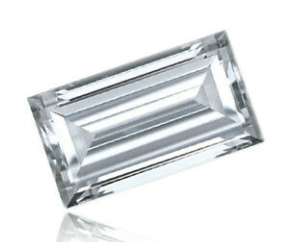
Notice how its facets stretch across the table, spanning the length of the diamond.
Some baguette cuts are closer to a square than a long rectangle, but most have a length two to four times longer than its width.
They aren’t often used as the center diamond on an engagement ring because of low brilliance.
Instead, baguette cuts are placed beside the center stone as accents because they complement all other shapes. It’s an effective way to add another cut to your diamond ring without distracting from the gem at its center.
What is an Emerald Cut Diamond?
An emerald cut diamond has a long, rectangular shape with straight linear facets.
These facets run parallel down the stone and create a large surface area. Instead of square corners like a baguette cut, its corners are cropped diagonally to create polished edges.
Check out this high-resolution image of an emerald cut diamond from the vendor where I bought my wife’s engagement ring.
Pay attention to how its facets are smaller than the baguette cut above. They don’t stretch as far across the diamond.
Emerald cuts are used as the primary diamond in engagement rings because they’re less expensive than brilliant cuts. You could purchase a higher carat weight for the same price as a cut such as round or princess.
It’s important to differentiate an emerald cut from a green emerald gemstone.
The former refers to the shape of the diamond and the way its facets are cut, while the latter is stone made from a mineral distinct from diamond.
How do Baguette and Emerald Cuts Differ?
1. Facets
Facets are the flat surface on a diamond that refract light. The way they’re cut from the rough diamond determines its shape and distinguishes one cut from another.
Baguettes have 14 facets, and emerald cuts have 58. Though they have a different number of facets, the shapes are similar and form open, large tables.
On the emerald cut engagement ring below, identify the table created by the facets on top.
It’s the most prominent position on the diamond that captures and reflects the most light.
Each facet is a square or rectangle, but emerald cut facets create an additional flash known as a “hall of mirrors” effect.
This phenomenon makes the facets appear to never end as they approach the middle of the diamond.
2. Brilliance
An advantage of emerald cuts is they have a strong amount of brilliance compared to baguettes.
The number of facets, and the quality of their cut, determines how light enters and exits the diamond, so more facets generally equals better light return.
A baguette cut’s light performance is often described as a warm glow.
It’s created by long, rectangular facets in contrast with the small, kite-shaped facets in brilliant cuts such as round, princess, and marquise diamonds.
As a comparison, here’s an engagement ring with brilliant cut facets.
They’re far smaller than what you’ll find in an emerald or baguette. This allows it to collect and return more light, as it bounces around tiny facets.
If you’re searching for a diamond with maximum brilliance, emerald and baguette cuts both fall short.
3. Shape
When you first view a baguette and emerald cut, you might determine they have identical shapes. Both are elongated and rectangular, easily distinguishable from other popular shapes such as round, pear, or marquise cut diamonds.
But examined more closely, the difference in shape between baguette and emerald cuts becomes more apparent.
The primary point of comparison is their corners.
Baguette cuts have squared corners that create sharp points and a total of four sides.
Rotate this image of tapered baguettes on an engagement ring to view them from every angle.
Emerald cuts’ corners are diagonal with a flat edge, creating eight sides. The lengths and widths are longer than the flat edges, so it doesn’t form into a traditional octagon, where all the sides are of equal length.
There are also variations of shape within the baguette cut.
A tapered baguette angles inward as it slopes from one side to the other. This results in two width measurements, where one end can be 50 percent longer than the other.
While emerald and baguette cuts have a similar shape, tapered baguettes aren’t as easily confused with emerald cuts.
4. Price
All else being equal, a baguette cut is less expensive than an emerald cut because the quality of the cut is lower. It has less brilliance and is in less demand as a center stone.
It’s difficult to compare prices for baguette versus emerald cuts because most diamond retailers don’t sell loose baguette diamonds.
They’re often placed within a setting instead of used as the primary stone, so they aren’t sold individually.
There are some instances in which you’ll pay a higher price for a baguette diamond. They’re graded along the four Cs of color, cut, clarity, and carat, so if it scores on the high end of these criteria, the price goes up.
But both cuts are less expensive than brilliant cuts because they preserve more of the original rough diamond. For example, let’s take emerald cut diamonds from online diamond retailer James Allen that have the following qualities:
- Carat: 1.00
- Color: F
- Clarity: VS1
The average price is $4,183, and the range is between $3,980-$4,470.

Compare that to a round cut with the same qualities. The average price is $6,775, and the range is $5,340-$8,410.
That’s a 38 percent decrease in average price for emerald cuts, with a savings of $2,592.
The difference would be more pronounced in the average baguette cut.
5. Popularity
Emerald cuts are more popular in jewelry than baguette cut diamonds.
They’re one of the most popular types of step cuts, compared to others such as Asscher and carré.
According to Town & Country, emerald cuts make up about 3 percent of diamonds sold, which makes them the fifth most popular cut. Baguette cuts rank tenth at less than one percent.
You can see the appeal of emerald cuts as the center stone in engagement rings by viewing the one below.
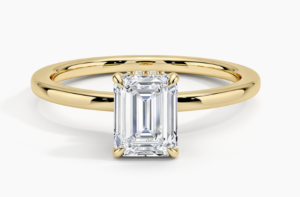
It has a wide surface area and sleek, modern aesthetic.
You’re more likely to see baguettes surrounding a center diamond than as the main feature.
Their minimal facets and elongated shape diminish its brilliance, which means it’s not coveted in the middle of the piece.
They gained prominence in the 1920s and 1930s during the Art Deco and Art Nouveau periods. These movements focused on the geometric form of clean, straight lines.
Although the baguette cut satisfies those criteria, its brilliance doesn’t match what’s needed for a center stone.
6. Variety of Styles
Emerald cuts are sold as loose diamonds and atop engagement rings, so there’s a higher variety of styles available versus baguette cuts.
All of the prominent jewelry retailers feature a selection of emerald cuts, but few offer that same range of options in baguette.
For example, Blue Nile, an online retailer, lists more than 15,000 varieties of emerald cuts. They range in size from 0.3 carats to 20 carats, with multiple cuts, colors, and clarity in between.
Additionally, James Allen has more than 7,000 loose emerald cut diamonds available.
Baguette cuts, on the other hand, aren’t often sold as loose diamonds.
Instead, they come as part of a setting. It’s not the focus of the piece.
Where you’ll see baguette diamonds featured prominently is eternity rings.
In the example above, two rows of baguette diamonds are placed around the ring, giving it an elegant look. The use of baguettes lowers the cost but still gives it the shine you’d expect from a diamond ring.
One style that combines the two is a three-stone baguette setting. To illustrate, here’s this style of ring with an emerald cut diamond in the center surrounded by two baguettes.
The baguette cuts aren’t tapered, which is unusual when they’re placed next to the main diamond.
7. Durability
Durability is a top concern when buying a diamond.
In comparing the durability of emerald versus baguette cuts, baguettes are less durable because of their sharp corners.
Here’s a comparison of the corners and edges of the two cuts.
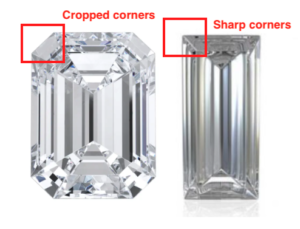
One danger of diamonds with pointed corners is those edges are more likely to chip if struck against a hard surface.
Conversely, the wedged-shaped corners on an emerald cut are less liable to break.
Aside from their corners, the most important factor in regard to durability is the number, type, and size of inclusions.
These flaws in a diamond have the potential to weaken its structure.
By choosing a diamond free of problematic inclusions, such as large feathers or cavities in the corner, you can better protect your diamond.
I recommend starting your search at SI1 clarity and moving up the scale from there. It’s where you’ll find the right balance between value, eye-cleanliness, and durability.
Additionally, choosing a strong setting that protects its weakest points can extend the life of any diamond.
Do They Have Similarities?
Don’t Disguise Inclusions
One similarity is neither hides its inclusions as well as brilliant cuts. Blemishes take many forms but often appear as black spots, dark crystals, or white fissures throughout the diamond.
Diamonds with a high degree of brilliance can hide inclusions because of its strong light performance.
Because of the step-cut facets on emeralds and low number of facets on a baguette, its brilliance is diminished.
In a round cut diamond, any clarity grade SI1 or above on a diamond less than one carat usually hides inclusions from the naked eye.
For emerald and baguette cuts, you may have to move to VS1 clarity.
As an example, here’s an emerald cut with a SI1 clarity grade.
It’s easy to identify a few flaws in high-resolution, but they might disappear when viewed in a normal setting.
Show Color
Baguette and emerald cuts follow this same principle for color.
While brilliant cuts hide hints of yellow even if they aren’t graded colorless, you’ll have to move up the color scale a letter or two to achieve the same aesthetic with baguettes and emeralds.
For example, a round diamond with a J color grade may look colorless, but an emerald or baguette with the same grade will often have a noticeable yellow tint.

This is a result of its large table and step cut.
Is a Baguette or Emerald Cut Right For You?
If you’re comparing emerald versus baguette cuts, I recommend emerald cuts as the center diamond and baguettes as accents.
This is in line with how these cuts are traditionally used, and that’s for good reason.
You’ll pay a lower cost for the same carat weight compared to brilliant cuts, but choose a higher grade on the clarity and color scale.
It prevents your center diamond from having noticeable inclusions or a hint of yellow.
For baguette cuts, you can’t go wrong placing them around the main diamond in a three-stone setting. Both regular and tapered baguettes are exceptional at framing a diamond and adding a soft glow to the ring.
You’ll build the perfect piece of jewelry you can wear for years to come.

Jacob Clarke
Jacob Clarke is the founder of TeachJewelry.com.
He earned an Applied Jewelry Professional Diploma from the Gemological Institute of America (GIA) and now brings you essential information about diamonds, settings, and more.
Jacob has consulted with leading jewelry brands, and his work has been cited in Clean Origin, Diamond Nexus and industry publications.
He's also a member of the International Gem Society.
He enjoys discussing jewelry with readers, so contact him with any questions at jacob.clarke@teachjewelry.com.

